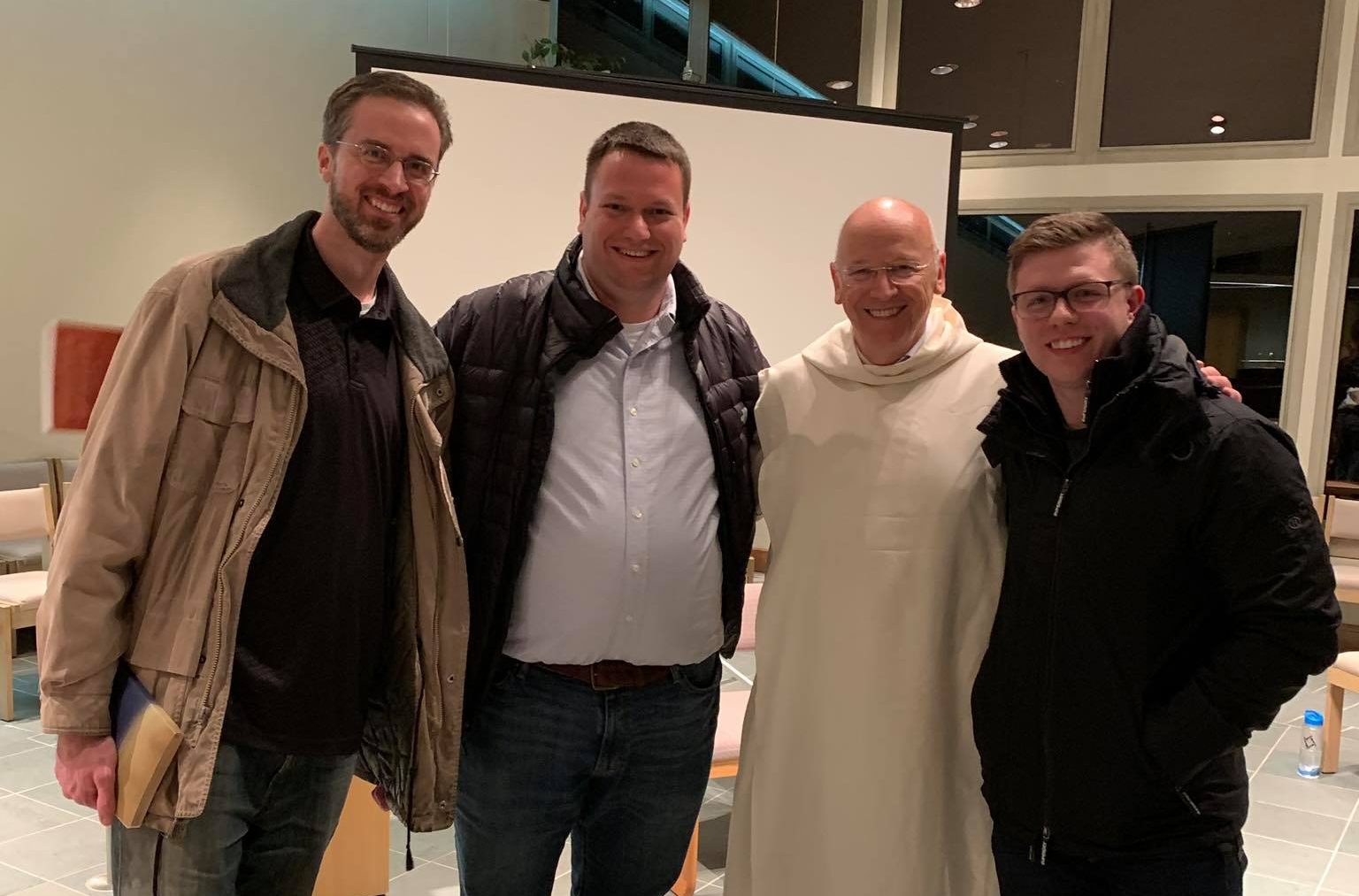
Last night I had the wonderful opportunity to attend a lecture with Fr. Laurence Freeman, OSB, at the Carmelite Monastery of Baltimore in Towson, Maryland. It was sponsored by the Carmelite Sisters of Baltimore, and the Benedictine Sisters of Emmanuel Monastery, as well as The World Community for Christian Meditation, of which Freeman is the director. Freeman is a Catholic priest and Benedictine monk of Turvey Abbey in England, a monastery of the Olivetan Congregation, an international speaker, retreat leader, teacher, and author of many books and articles.
I was also able to meet up with my new friends again, Michael Potter and Jory Pryor. They too have passed through deconstructing phases on their spiritual journeys, coming from very different religious traditions, and are deeply interested in mysticism, science, and an interspiritual approach to faith. I am so grateful for these two people, for their insight, their enthusiasm (literally en-theos, “possessed by God”), their humility, their sincere seeking, their goodness, and their friendship.

Fr. Freeman’s talk was on “The Doors of Perception,” and he focused almost exclusively on discussion about contemplation, and the kind of meditation that leads to contemplation, specifically in the Christian tradition. We also spent about twenty minutes meditating with him in the contemplative prayer tradition. I will share some notes I took from his lecture.
We can make our minds
(William Butler Yeats, 1902)
so like still water
that beings gather about us
that they may see,
it may be, their own images,
and live for a moment with a clearer,
perhaps even with a fiercer life
because of our quiet,
our silence.
Contemplation is the experience of the present.
I sat, a solitary man,
(William Butler Yeats, 1933)
In a crowded London shop,
An open book and empty cup
On the marble table-top.
While on the shop and street I gazed
My body of a sudden blazed;
And twenty minutes more or less
It seemed, so great my happiness,
That I was blessed and could bless.
Contemplation is a way of seeing.
St. Thomas Aquinas said that contemplation is “the simple enjoyment of the truth,” childlike simplicity.

Meditation becomes a priority in our lives when we see that it is a priority, not think that it is.
We never lose contemplation (after passing out of childhood), we just recover it.
St. Augustine said, “Our whole business therefore in this life is to restore to health the eye of the heart whereby God may be seen.”
John Main – “In meditation we accept the gift of our being.”
William Blake – “If the doors of perception were cleansed every thing would appear to man as it is, Infinite.”
St. Irenaeus – “We can never know God as an object but only by sharing in God’s own self-knowledge.”
Meister Eckhart – “There is nothing so much like God in all the universe as silence.”
Silence is that experience that is most like God.
The essential work of silence is paying attention in an objectless way. That’s the essence of meditation.
The older meaning of the word meditation was “to repeat,” “to chew.”
St. Benedict – the monk is one who “truly seeks God.”
Monks are like the Old Testament prophets, non-conformists, on the fringes.
People today are less religious, but perhaps more contemplative.
Karl Rahner – “The Christian of the future will be a mystic or he will not exist at all.”
Theoria (contemplation) – vision, seeing things as they actually are. Seeing God by participating in God’s own self-knowing.
Contemplation, or “con-templatio,” means being in or with the temple.
Templum was not the building, but the space, the spaciousness of the experience. All the institutions we build are mortal and finite, but the space is eternal.
We are each a microcosm of the universe.
The true scientist is a contemplative, not a narrow materialist.
The only morality of Jesus was the morality of Love.
Contemplation is a work of Love. Loving ourselves. Seeing God from within God.
The Desert Fathers said that prayer is “the laying aside of thoughts.”
Romans 12 – offer your very selves to Him, let your minds be remade, and let yourselves be transformed. Then you will know the will of God. You’ll see clearly. You’ll know what you need to do.
Jesus – set your mind first on the kingdom, and the rest will come.
(The painting at the top of this post is “Man of Sorrows,” by William Dyce, oil on board, circa 1860, owned by the Scottish National Gallery.)
Discover more from Thy Mind, O Human
Subscribe to get the latest posts sent to your email.
I’d be interested in your thoughts on childhood and contemplation. One of your quotes mentions that and I had never really thought about children and contemplation.
Thank you for your posts.